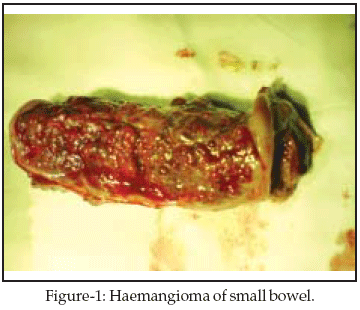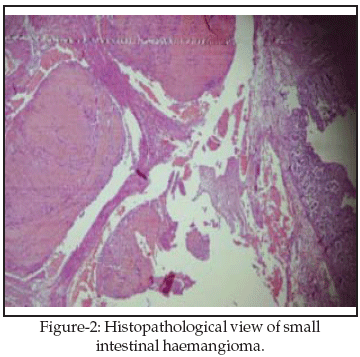|
|
||||
|
Published by : PROFESSIONAL MEDICAL PUBLICATIONS |
||||
|
ISSN 1681-715X |
||||
|
||||
|
- |
||||
|
CASE REPORT |
||||
|
- |
||||
|
Volume 24 |
July - September 2008 |
Number 4 |
||
|
|
||||
|
|
||||
|
|
||||
|
Published by : PROFESSIONAL MEDICAL PUBLICATIONS |
||||
|
ISSN 1681-715X |
||||
|
||||
|
- |
||||
|
CASE REPORT |
||||
|
- |
||||
|
Volume 24 |
July - September 2008 |
Number 4 |
||
|
|
||||
|
|
||||
Small bowel haemangioma: A rare cause
of intestinal obstruction in infant
Nandlal Kella1, Prem Kumar Rathi2,
Shankerlal Rathi3, Mohammad Ali Qureshi4
ABSTRACT
Haemangiomas of small bowel are rare benign tumors. They present diversely, with intestinal obstruction being rare. We describe a two years old female baby with intestinal obstruction. Exploration revealed a diffusely infiltrating haemangioma of middle one third of ileum. Resection of affected segment and end to end bowel anastomosis was made. Post- operative recovery was un- eventful. Histopathological report was consistent with capillary haemangioma of small intestine.
KEY WORDS: Small bowel haemangioma, Intestinal obstruction, Infant.
Pak J Med Sci July - September 2008 Vol. 24 No. 4 629-631
How to cite this article:
Kella N, Rathi PR, Rathi S, Qureshi MA. Small bowel haemangioma: A rare cause of intestinal obstruction in infant. Pak J Med Sci 2008;24(4):629-31.
1. Dr. Nandlal Kella, FCPS,
Assistant Professor,
Dept. of Paediatric Surgery,
Liaquat University of Medical and Health Sciences,
LUMHS, Hyderabad.
2. Dr. Prem Kumar Rathi, FRCS,
Assistant Professor,
Dept. of General Surgery
LUMHS Hyderabad
3. Dr. Shankerlal Rathi, M Phil,
Professor of Histopathology,
Dept. of Pathology,
LUMHS, Hyderabad.
4. Dr. Mohammad Ali Qureshi,
Resident Paediatric Surgery,
LUMHS, Jamshoro – Sindh. Pakistan.
Correspondence
Dr. Nandlal Kella,
House No. 22 B Al-Meeran Town,
Behind Citizen Plaza, Qasimabad,
Hyderabad - Pakistan.
E-mail: nckella@yahoo.com
* Received for Publication: May 20, 2008
* Accepted: July 15, 2008
INTRODUCTION
Infantile haemangiomas are benign vascular lesions, composed of proliferating plump endothelial cells.
1 Small bowel haemangiomas are uncommon benign tumour, which are rarely encountered in clinical practice and are rare cause of intestinal obstruction in children.2 Clinical presentation varies and may be misleading due to lack of awareness of the clinical condition; occasionally the diagnosis is made during surgery. We report such a case that presented with acute intestinal obstruction along with brief review of literature.CASE REPORT
A two years old female child presented with three days history of acute abdomen. Clinical examination revealed distended and tender upper abdomen. There was a palpable tubular mass at central abdomen. Per rectal examination was insignificant. X-ray abdomen showed multiple air fluid levels while ultrasound was suggestive of intussusception. Laboratory investigations were within normal limits.

On exploration, we found haemangioma of ileum involving approximately 25cm of middle one third of ileum (Figure-1). Resection of involved segment and end to end anastomosis was done. Post operative recovery was symptom free. Histopathological examination revealed a capillary haemangioma of small intestine (Figure-2). Patient is on regular follow-up without any symptom.

DISCUSSION
Haemangiomas are defined as masses of capillaries, blood filled endothelial lined spaces or a combination of them. Haemangiomas of small bowel are uncommon and accounting for only 0.05% of intestinal neoplasia and 7-10% of all benign tumors of small intestine.
2,3 Haemangiomas of infancy occurs in 10-12% of white infants, 14% of black infants and 0.8% of Asian infants with male to female ratio 1:3 to 1:5. Favorable site in small bowel for haemangioma is jejunum, but in our case it was ileum. Haemangioma of intestine may be solitary or multiple and they may manifest as a segment of different syndromes; Blue rubber bleb syndrome, Maffucci syndrome and Klipple-Trenaunay-Weber syndrome.4 Intestinal haemangioma has also been reported in Peutz-Jeghers syndrome.Etiology of haemangiomas is still unknown, but it is believed that these tumors are angiogenesis dependent. This process is tightly controlled by inhibition of endothelial cell growth. Haemangioma could result from a localized diminution of normal angiogenesis inhibition or increased production of angiogenetic stimulator.
5Haemangiomas of small intestine present either as polypoid masses projecting into the lumen or as diffusely infiltrating lesions involving long segment of gut,
6 as in our case. Most common manifestation of intestinal haemangioma is acute or chronic bleeding, although some time they may present with volvulous, intussusception, and perforation and very rarely intestinal obstruction as in our case.7Modern imaging studies can usually establish the diagnosis of intestinal haemangioma or at least can raise a strong suspicion. Abdominal radiography may reveal a phlebolith which is due to thrombus formation in tumor; its absence does not exclude the diagnosis of haemangioma. Ultrasound, double contrast barium enema, CT scan and MRI are helpful in diagnosis of haemangioma.
8 Laparoscopy is more suitable for diagnosis but is not so much helpful for resection and anastomosis. Laparotomy is final mode of diagnosis as well as resection and anastomosis which we have done in our case. Naked eye examination is also a reasonable diagnostic parameter of haemangioma but its types can be further assesed on histopathological examination.The majority of intestinal haemangioma are cavernous type, in our case it was capillary haemangioma.Haemangioma of small intestine is rare though it may present as intestinal obstruction. It should be kept in mind while handling cases of acute abdomen in infants.
REFERENCES
1. Corsi A, Ingegnoli A, Albelli P, Chaira FD, Maucini C, Cavestro GM, et al. Imaging of small bowel cavernous haemangioma: Report of a case with emphasis on the use of computed tomography and enteroclysis. Acta Biomed 2007;78:139-43.
2. Boyle L, Lack BE. Solitary cavernous haemangioma of small intestine. Case report and literature review. Arch Pathol Lab Med 1993;117:939-41.
3. Eenoglio-Preiser CM, Lantz P, Listrom MB, Davis M, Rilke FO. Gastrointestinal pathlogy; An Atlas and Text Book. New York. Raven Press, chapter 16.1989;569-71.
4. Wilson Cl, Song LM, Chau H. Bleeding from cavernous angiomatosis of the rectum in Klipple-Trenaunay-Weber syndrome; report of three cases and literature review. Am J Gastroenterol 2001;96(9):2783-8.
5. Jaswal TS, Singh S, Marwah N, Marwah S, Singh H, Arora B. Acute intestinal Obstruction due to small gut haemangioma. Indian J Gastroenterol 2002;21(6):233- 4.
6. Jones AF, Ainsworth BH, Desai A, Tsang TT. Small bowel haemangioma diagnosed with laparoscopy: Report of two cases. J Min Asces Surg 2007;3(1):29-31.
7. Fisherman SJ, Burrows PE, Leichtuer AM, Mulliken TB. Gastrointestinal manifestation of vascular anomalies in childhood: varied etiologies require multiple therapeutic modalities. J Pediatr Surg 1998;33(7):1163-7.
8. Yorozuka K, Watanabe M, Hasegawa H. Diffuse cavernous haemangioma of the rectum: Report of a case. Surg Today 2003;33:309-11.
HOME | SEARCH | CURRENT ISSUE | PAST ISSUES
Professional
Medical Publications
Room No. 522, 5th Floor, Panorama Centre
Building No. 2, P.O. Box 8766, Saddar, Karachi - Pakistan.
Phones : 5688791, 5689285 Fax : 5689860
pjms@pjms.com.pk